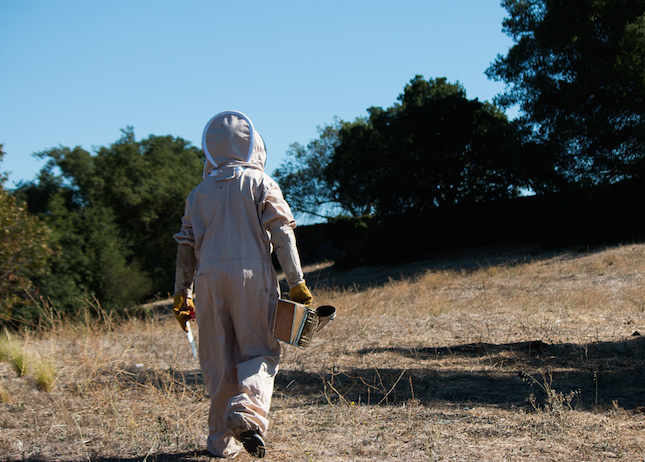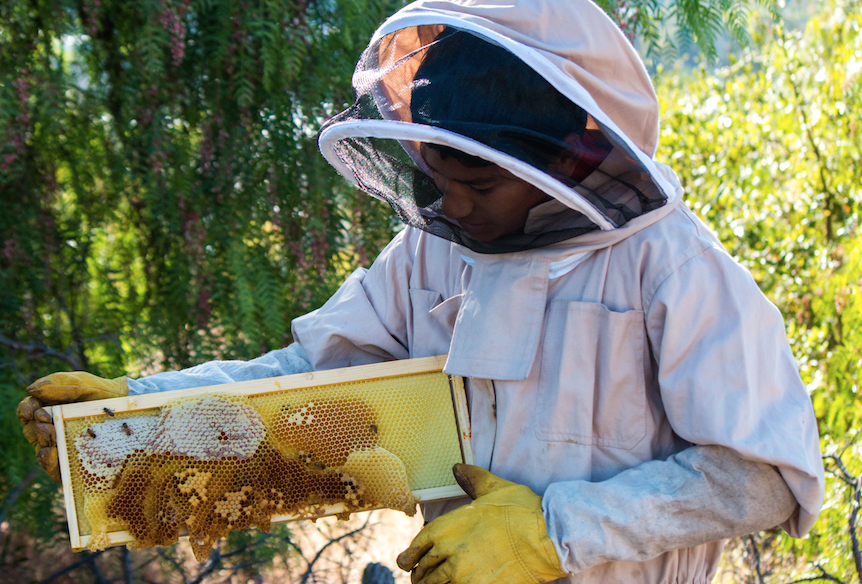Student has Cal abuzz with unique hobby
Sophomore Tarun Rajan brings beekeeping to Cal through his club
It’s a warm summer morning and Tarun Rajan has just woken up. He grabs himself a cup of coffee, puts on his beekeeping suit and takes the five minute walk to his beehive.
Bees lazily drift around in the air above the hive, and many enter and exit through a tiny hole at the bottom. Rajan ignites a small pellet, and puts it in the smoker. As the wispy smoke draws near the hive, bees float downwards and regress inside.
He pries open the top of the hive, and looks at every slide carefully, searching for irregularities and making sure the bees are healthy.
He breaks the edge of a comb, and honey begins to flow out of it. Licking some off of his finger, he can tell that this year’s harvest is going to be exquisite.
Rajan’s beekeeping business started when he crashed a $400 drone that he bought for himself, and stumbled upon a beehive near an underground water pipeline.
After that, something rather unusual must have happened in the sophomore’s mind, as he spent the next few days doing research on bees instead of taking AP Euro notes. Right afterwards, he returned his drone and, with the approval of his family, bought a beehive.
“I really wanna go into the medical field,” he said. “[But] I love my business, I’d probably choose my business over [the medical field].”
Rajan filled his new hive with the wild bees that first got him into beekeeping. To do this, he attached a frame to a piece of string in a zigzag pattern, so that the frame was perfectly still. After making space for the frame, Rajan lowered it as near to the hive as he could, and simply waited. Eventually, the frame was full and contained a queen, so he carried it to the hive, and began his new career.
He has rescued three hives in this fashion, and is expecting huge growth in San Ramon.
“I ordered about 50 beehives from China,” says Rajan. “I plan on growing extensively.”
With this growth come new methods of locating the hives.
In one method, Rajan places a paper plate laced with a synthetic sugar on the ground, and simply waits with a stopwatch in hand. When a bee arrives, he waits for it to start flying back again, and starts the stopwatch, noting the direction it flew in. The bee will return with more of the hive to harvest the material, and Rajan will stop the watch.
Then, all he needs to do is divide the time he got by two, and multiply that by the speed bees fly at. Now he knows in what direction and how far away the nearest hive is.
“Sometimes I go out bee hunting with him,” says Aishwarya Rajan, his sister. “It’s really cool.”
Rajan is dedicated to beekeeping by inspecting his hive every two weeks to make sure it’s healthy. A frame filled with eggs, larvae, and pupae is considerably more healthy than one without them. These frames are separate from the ones that store honey, which makes extraction of honey possible.
His first batch of honey yielded 16 8oz jars, some of which was kept, while the rest was sold door-to-door.
“I’m allergic to bees…” Rajan said, “but if you tackle it you’ll be fine. Really, if a bee’s on you, it thinks you’re a landmark… just don’t do anything, it’ll fly off, and you’ll be fine”
Sophomore Aproop Kamat, along with many others, tends to agree that bees aren’t the nicest insects to have nearby.
“If I was dining outside with my family, I’d probably try to kill it [the bee],” Kamat said.
Rajan’s father, K. V. Rajan, admits that he and his wife were at first reluctant to be a part of the business, but with time, they got past the stigma of “see a bee, run.”
“Little did we expect, it grew into something that’s so much fun,” said K. V. Rajan.
But with the water supply in California at an all-time low and much of California’s land covered with concrete buildings, roads, and houses, how do the bees survive in a suburban city of 70,000?
In fact, the drought hasn’t affected the bees that much, as they can fly up to three miles in search of flowers.
The most serious danger to the hive is Colony Collapse Disorder, which occurs when bees go out to retrieve nectar, forget where their hive is and die. Recently, Colony Collapse Disorder has been plaguing the bees and their populations are dwindling.
Rajan said his goal with beekeeping is simply the survival of the species.
“I’m trying to help the honeybee population recover from this devastating disorder,” he said.
One of the few ways that those who don’t own a beehive can help is by petitioning the local legislature to allow more bees on smaller areas of land. Currently the minimum is an acre, which is completely unnecessary, according to Rajan.
Another is to join Rajan’s school club, the Beekeeping Club. Rajan is the president, and has some big goals for the future. The first meeting attracted lots of attention.
“Tarun’s club was as sweet as honey,” sophomore Leron Reznikov said.






